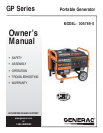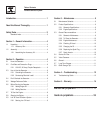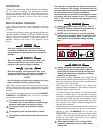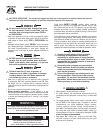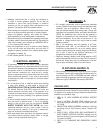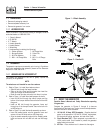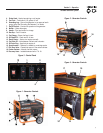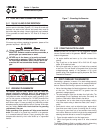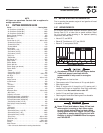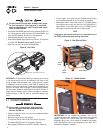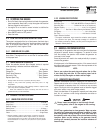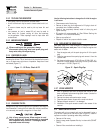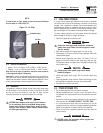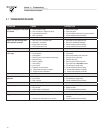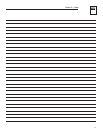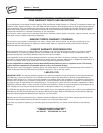
6
Section 2 – Operation
Portable Generator System
2.2 CORD SETS AND CONNECTION PLUGS
2.2.1 120 VAC, 20 AMP, DUPLEX RECEPTACLE
This is a 120 Volt outlet protected against overload by a 13.5 Amp
push-to-reset circuit breaker (Figure 6). 13.5 Amps of current may
be drawn from each socket, however, total power drawn must be
kept within data plate ratings. Use only high quality, well insulated,
3-wire grounded cord sets rated for 125 Volts at 20 Amps (or
greater).
2.3 HOW TO USE THE GENERATOR
If there are any problems operating the generator, please call the
generator helpline at 1-888-436-3722.
DANGER
Using a generator indoors WILL KILL YOU IN
MINUTES. Exhaust contains carbon monoxide, a
poison gas you cannot see or smell.
NEVER use in the home, or in partly enclosed
areas such as garages. ONLY use outdoors and
far from open windows, doors, vents, and in an
area that will not accumulate deadly exhaust
gas.
Using a generator indoors WILL KILL YOU IN MINUTES. Exhaust contains
carbon monoxide, a poison gas you cannot see or smell.
NEVER use in the home or in partly enclosed areas such as garages.
ONLY use outdoors and far from open windows, doors and vents.
DANGER
2.3.1 GROUNDING THE GENERATOR
The National Electrical Code requires that the frame and
external electrically conductive parts of this generator be
properly connected to an approved earth ground (Figure 7).
Local electrical codes may also require proper grounding of the
unit. For that purpose, connecting a No. 10 AWG (American Wire
Gauge) stranded copper wire to the grounding lug and to an
earth-driven copper or brass grounding rod (electrode) provides
adequate protection against electrical shock. However, local codes
may vary widely. Consult with a local electrician for grounding
requirements in the area.
Proper grounding of the generator will help prevent electrical
shock in the event of a ground fault condition in the generator
or in connected electrical devices. Proper grounding also helps
dissipate static electricity, which often builds up in ungrounded
devices.
Figure 7 - Grounding the Generator
2.3.2 CONNECTING ELECTRICAL LOADS
DO NOT connect 240 Volt loads to 120 Volt receptacles. DO NOT
connect 3-phase loads to the generator. DO NOT connect 50 Hz
loads to the generator.
Let engine stabilize and warm up for a few minutes after •
starting.
Plug in and turn on the desired 120 or 240 Volt AC, single •
phase, 60 Hz electrical loads.
Add up the rated watts (or amps) of all loads to be connected •
at one time. This total should not be greater than (a) the rated
wattage/amperage capacity of the generator or (b) circuit
breaker rating of the receptacle supplying the power. See "Don't
Overload the Generator".
2.4 DON’T OVERLOAD THE GENERATOR
Overloading a generator in excess of its rated wattage capacity
can result in damage to the generator and to connected electrical
devices. Observe the following to prevent overloading the unit:
Add up the total wattage of all electrical devices to be connected •
at one time. This total should NOT be greater than the
generator's wattage capacity.
The rated wattage of lights can be taken from light bulbs. The •
rated wattage of tools, appliances and motors can usually be
found on a data label or decal affixed to the device.
If the appliance, tool or motor does not give wattage, multiply •
volts times ampere rating to determine watts (volts x amps =
watts).
Some electric motors, such as induction types, require about •
three times more watts of power for starting than for running.
This surge of power lasts only a few seconds when starting
such motors. Make sure to allow for high starting wattage when
selecting electrical devices to connect to the generator:
1. Figure the watts needed to start the largest motor.
2. Add to that figure the running watts of all other connected
loads.
The Wattage Reference Guide is provided to assist in determining
how many items the generator can operate at one time.



